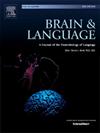Effects of object familiarity on children’s silent gestures
IF 2.3
2区 心理学
Q1 AUDIOLOGY & SPEECH-LANGUAGE PATHOLOGY
引用次数: 0
Abstract
When gesturing (with or without speech) actions done with objects, young children and adults with apraxia often produce a body-part-as-object (BPO), like an extended finger for a toothbrush. In contrast, older children and neurotypical adults often produce an imagined object (IO), like pretending to hold a toothbrush. The purpose of this study was to test whether IOs are produced when children have a rich conceptual understanding of the functions of an object. If so, children should produce more IOs (relative to BPOs) with familiar than with unfamiliar objects. Children between three and five years old were asked to demonstrate what to do with either familiar or unfamiliar objects. As predicted, the children produced more IOs with familiar than unfamiliar objects. These results are consistent with the argument that children’s handshape when gesturing reflects the richness of their understanding. Developmental change likely occurs as children develop a rich understanding of many objects.
物体熟悉度对儿童无声手势的影响
患有失用症的儿童和成人在用物体做手势(有或没有语言)时,通常会做出身体部位即物体(BPO)的动作,比如伸出手指拿牙刷。相比之下,大一点的孩子和神经正常的成年人经常会产生一个想象的物体(IO),比如假装拿着牙刷。本研究的目的是测试当儿童对物体的功能有丰富的概念性理解时是否会产生IOs。如果是这样,儿童在熟悉的物体上产生的io(相对于bpo)应该比不熟悉的物体多。三到五岁的孩子被要求演示如何处理熟悉或不熟悉的物体。正如预测的那样,孩子们对熟悉的物体比不熟悉的物体产生更多的IOs。这些结果与儿童在做手势时的手型反映他们理解的丰富程度的论点是一致的。当孩子们对许多事物有了丰富的理解时,可能会发生发展变化。
本文章由计算机程序翻译,如有差异,请以英文原文为准。
求助全文
约1分钟内获得全文
求助全文
来源期刊

Brain and Language
医学-神经科学
CiteScore
4.50
自引率
8.00%
发文量
82
审稿时长
20.5 weeks
期刊介绍:
An interdisciplinary journal, Brain and Language publishes articles that elucidate the complex relationships among language, brain, and behavior. The journal covers the large variety of modern techniques in cognitive neuroscience, including functional and structural brain imaging, electrophysiology, cellular and molecular neurobiology, genetics, lesion-based approaches, and computational modeling. All articles must relate to human language and be relevant to the understanding of its neurobiological and neurocognitive bases. Published articles in the journal are expected to have significant theoretical novelty and/or practical implications, and use perspectives and methods from psychology, linguistics, and neuroscience along with brain data and brain measures.
 求助内容:
求助内容: 应助结果提醒方式:
应助结果提醒方式:


